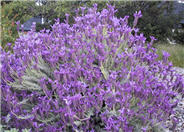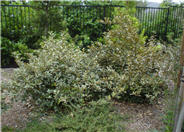
Common name:Spanish Lavender
Botanical name:Lavandula stoechas
This dense shrub grows 2-3 ft. tall with blue gray foliage and deep purple flowers that have large showy bracts near the top of the spikes. It is drought tolerant . - Cornflower Farms

Common name:Rosemary
Botanical name:Rosmarinus officinalis
Rosemary is hardy in full sun areas where winter temperatures do not drop below 10 degrees F. They can be grown in a clay pot with well-drained, porous soil in bright indoor light, and will also flourish on the backporch in spring, summer and fall. Its beautiful, slowly trailing stems and shiny slender leaves are perfect for showing off the small light blue flowers that blossom in the summer. -Holland WIldflower Farm

Common name:Fruitland Silverberry
Botanical name:Elaeagnus pungens 'Fruitlandii'
Evergreen shrub to about 15' overall. Large silvery leaves with rusty dots. Armed with spines. Good for hedge or dense barriers. Can be sheered; tolerates heat and wind.

Common name:Red Damask Tea Tree
Botanical name:Leptospermum scoparium 'Red Damask'
Leptospermum sco. is an evergreen shrub or tree. 1/2 in. flowers are showy. Branches densely set with needlelike green leaves.

Common name:Chamomile, Roman Chamomile
Botanical name:Chamaemelum nobile
This evergreen perennial will grow 3-12" tall and works well as a groundcover. It produces flowers from midsummer to fall and does best in light shade to full sun. It can be mowed occasionally to control height; makes good lawn substitute.

Common name:Hybrid White Rockrose
Botanical name:Cistus X hybridus
This is a small evergreen shrub with 2 in. long gray-green crinkly leaves. It has pure white flowers with prominant yellow stamens . It is produced throughout the spring to early summer. Avoid heavy mulches. Also sold as Cistus corbariensis.

Common name:French Lavender, Toothed Lavender
Botanical name:Lavandula dentata
This lavender has green leaves and will grow 3' H x 5' W. It has lavender flowers that are prominent in the spring and summer months.
| Designer: | Pavers Lined with Groundcover |
Photographer: GardenSoft |
Soils and Compost:
Maintain a two to four inch layer of mulch on the soil surface to reduce weeds, infiltrate rain water, and reduce compaction.
Water Saving Tip:
Apply a 2-3 inch layer of mulch in planting beds to conserve water, suppress weeds, and protect the soil from compaction and erosion.
Integrated Pest Management:
Attract, or buy beneficial insects such as ladybugs and lacewings to control pest outbreaks in your garden.

